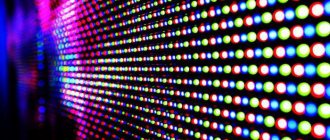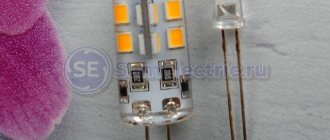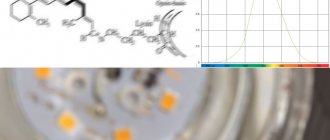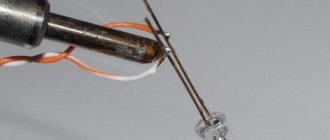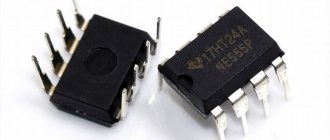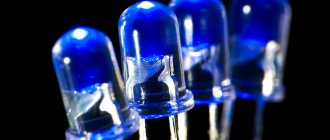LED device
LEDs are semiconductor devices with an electron-hole junction that creates optical radiation when an electric current is passed through it in the forward direction.
The light emitted by an LED lies in a narrow range of the spectrum. In other words, its crystal initially emits a specific color (if we are talking about LEDs in the visible range) - in contrast to a lamp that emits a wider spectrum, where the desired color can only be obtained by using an external light filter. The emission range of an LED largely depends on the chemical composition of the semiconductors used.
General characteristics of LED sources
How to choose the LED of the desired configuration? To do this, it is important to understand the main characteristics. One of them is current consumption. Stabilizers and limiters are selected for this value. For calculations you need to know the voltage. To effectively replace incandescent lamps with LED sources, you need to calculate the power.
When creating a specific interior, it is important to consider the size of the light-emitting diode, as well as the shade of the luminous flux. When dealing with LED sources, it is customary to take into account the angle of illumination. Having understood the listed parameters, you can choose the most suitable LED.
When choosing LEDs, it is important to consider the following characteristics: current, voltage, power, efficiency, beam angle, device size
LED current consumption
Current stabilizers are very important in the operation of LEDs. Even a slight fluctuation in the current value will lead to a change in the light shade emitted by the crystals to a cooler one and premature failure of the lighting device. A significant jump in electric current leads to instantaneous burnout of the diode.
LED lamps are always equipped with stabilizers for current conversion. A separate light-emitting diode must be connected using a resistor to limit the current. One crystal typically requires a current of 0.02 A. Four crystals will require a correspondingly higher current of 0.08 A.
Operating principle of LEDs
Any LED has a pn junction. Glow occurs when electrons and holes recombine in an electron-hole transition. A Pn junction is created when two semiconductors of different types of electrical conductivity are connected. The n-type material is doped with electrons, the p-type with holes.
When voltage is applied, electrons and holes in the pn junction begin to move and take up space. When charge carriers approach the electron-hole junction, electrons are forced into the p-type material. As a result of the transition of electrons from one energy level to another, photons are released.
Not every pn junction can emit light. For light to pass through, two conditions must be met:
- the band gap should be close to the energy of the light quantum;
- the semiconductor crystal must have a minimum of defects.
It will not be possible to implement this in a structure with one pn junction. For this reason, multilayer structures are created from several semiconductors, which are called heterostructures.
To create LEDs, direct-gap conductors with a permitted direct optical zone-to-zone transition are used. The most common materials are A3B5 (gallium arsenide, indium phosphide), A2B4 (cadmium telluride, zinc selenide).
The color of a light-emitting diode depends on the bandgap in which electrons and holes recombine. The larger the band gap and the higher the energy of the quanta, the closer to blue the emitted light is. By changing the composition, it is possible to achieve luminescence in a wide optical range - from ultraviolet to mid-infrared radiation.
LEDs in infrared, red and yellow colors are made on the basis of gallium phosphide, green, blue and violet - on the basis of gallium nitrides.
Color coding of light diodes
On the one hand, color marking allows you to determine the type and characteristics of the LED, on the other hand, there are no uniform designations.
Each manufacturer uses its own values. In Russia there is color coding, but it is rarely used - the list of elements consisting of numbers and letters is too large, it is quite difficult to remember, and decoding is inconvenient for the average buyer. A simpler letter designation is accepted as generally accepted (unofficially). Mainly used for LED strips. In addition to the general characteristics, the degree of protection of the element from the penetration of debris and moisture is indicated - IP and numbers from 0 to 6.
To choose a good option for replacing outdated light bulbs, you need to find out what kind of LEDs there are and set the parameters of the connected electrical network: voltage, current, resistance.
You can’t focus on cost - brands of cheap LEDs often have inflated parameters and use unstable materials.
Types of LEDs, classification
According to their intended purpose, indicator and lighting LEDs are distinguished. The former are used for stylization and decorative lighting - for example, decoration of buildings, advertising banners, garlands. Lighting fixtures are used to create bright lighting in a room.
By type of execution there are:
- Dip LEDs. They are crystals enclosed in a cylindrical lens. Refers to indicator LEDs. There are monochrome and multicolor devices. They are rarely used due to their disadvantages: large size, small angle of illumination (up to 120 degrees), drop in brightness of radiation by 70% during long-term operation, weak light flux.
Dip LEDs - Spider led. These LEDs are similar to the previous ones, but have 4 outputs. In such diodes, heat dissipation is optimized and component reliability is increased. Actively used in automotive technology.
- SMD – surface mount LEDs. May refer to both indicator and lighting LEDs.
Smd - Cob (Chip-On-Board) – the crystal is installed directly on the board. The advantages of this solution include protection against oxidation, small dimensions, effective heat dissipation and uniform lighting over the entire area. LEDs of this brand are the most innovative. Used for lighting. More than 9 LEDs can be installed on one substrate. The top of the LED matrix is covered with phosphor. They are actively used in the automotive industry to create headlights and turn signals, and in the development of televisions and computer screens.
Cob - Fiber - developed in 2015. Can be used in clothing production.
Fiber - Filament is also an innovative product. They are highly energy efficient. Used to create lighting lamps. An important advantage is the possibility of installation directly on a glass substrate. Thanks to this application, it is possible to spread light 360 degrees. The design consists of sapphire glass with a diameter of up to 1.5 mm and specially grown crystals that are connected in series. The number of crystals is usually limited to 28 pieces. LEDs are placed in a flask, which is coated with a phosphor. Sometimes filament LEDs may be classified as COB products.
Filament - Oled. Organic thin film LEDs. Used to build organic displays. They consist of an anode, a foil or glass substrate, a cathode, a polymer layer, and a conductive layer of organic materials. The advantages include small dimensions, uniform illumination over the entire area, wide beam angle, low cost, long service life, low energy consumption.
Oled
- A separate group includes LEDs that emit in the ultraviolet and infrared ranges. They can be with conclusions or in the form of SMD execution. Used in remote controls, bactericidal and quartz lamps, sterilizers for aquariums.
LEDs can be:
- flashing – used to attract attention;
- multi-color flashing;
- three-color - in one case there are several unrelated crystals that work both individually and all together;
- RGB;
- monochrome.
LEDs are classified by color. For the most accurate color identification, the device documentation indicates its emission wavelength.
White LEDs are classified by color temperature. They come in warm shades (2700 K), neutral (4200 K) and cool shades (6000 K).
LEDs are classified according to power, consuming units of mW to tens of watts. The intensity of the light directly depends on the power.
Why do you need to know power?
LED power is needed to select a suitable power source. Knowing the consumption of the LED, we can select the power supply it needs. Power calculations will allow you to avoid problems during further work or save money.
Let's look at examples to make it clear what we're talking about. For example, we have a light-emitting diode with an operating voltage of 3.5 Volts and a current of 0.1 Ampere. Using the power calculation formula P=I*U, we get the value P=3.5*0.1 => P=0.35 Watt. The power of ten will be 3.5 Watts or 1 Ampere. From this we conclude that to connect one LED we will need a power supply unit (PSU) with a power of 0.385 Watts (with a margin of 10%). To connect ten you will need a 3.85 W power supply (also with a 10% margin).
It is recommended to select a power supply for LEDs with a margin of 10-20%. This will prevent the power supply from operating at its limit, which in turn will extend its service life.
LED Polarity
LED Polarity
If turned on incorrectly, the LED may break. Therefore, it is important to be able to determine the polarity of a light source. Polarity is the ability to pass electric current in one direction.
Mono polarity can be determined in several ways:
- Visually. This is the easiest way. To find the plus and minus of a cylindrical diode with a glass bulb, you need to look inside. The cathode area will be larger than the anode area. If you can’t look inside, the polarity is determined by the contacts - the long leg corresponds to the positive electrode. SMD LEDs have markings indicating polarity. They are called a bevel or a key, which is aimed at the negative electrode. Small smds are marked with pictograms in the form of a triangle, the letter T or P. The corner or protrusion indicates the direction of the current - which means this pin is a minus. Also, some LEDs may have a mark that indicates polarity. It could be a dot, a ring strip.
- Using power connection. By applying a low voltage, you can check the polarity of the LED. To do this, you need a current source (battery, accumulator), to the contact of which an LED is applied, and a current-limiting resistor through which the connection occurs. The voltage needs to be increased and the LED should light up when turned on correctly.
- With the help of testers. The multimeter allows you to check the polarity in three ways. The first is in the resistance test position. When the red probe touches the anode and the black probe touches the cathode, a number other than 1 should light up on the display. Otherwise, the number 1 will light up on the screen. The second method is in the dial position. When the red probe touches the anode, the LED will light up. Otherwise he will not react. The third method is by installing an LED in the transistor socket. If a cathode is placed in hole C (collector), the LED will light up.
- According to technical documentation. Each LED has its own marking, which can be used to find information about the component. The polarity of the electrodes will also be indicated there.
The choice of polarity determination method depends on the situation and whether the user has the right tool.
Connection diagram options
It is possible to determine the optimal power supply circuit for a particular LED if its current-voltage characteristics and network parameters (battery, accumulator, household electrical network) are known.
If, for example, you need to connect an LED to a AA battery or several batteries, then a direct connection will lead to a rapid discharge of the source or burnout of the diode. Therefore, a resistor is included in the circuit to limit the electric current. To determine the resistance of the resistor, you need to subtract the voltage of the LED source from the voltage of the batteries, and divide the resulting result by the LED current. If there is no resistor with such parameters, you need to buy an element with the nearest higher value.
Attention! This is how you can make the simplest flashlight with your own hands.
Home craftsmen also use the following to power LEDs:
- 3.7 V batteries for mobile push-button phones;
- 5V tablet chargers;
- crown batteries (9 V);
- car batteries (12 V);
- laptop power supplies (19 V).
Based on chargers for phones and tablets, night lights are made from LED strips of 3.7 or 5 V. You need to glue a piece of the corresponding voltage to the case and connect it to a USB socket or board (if the case can be disassembled).
You can connect 2-3 SMD chips in series to a crown battery. Brightness can be adjusted using a miniature dimmer.
A 12V battery is enough to power 3 SMD LEDs, but when used in a car, a resistor or low voltage driver with current flow adjustment (with a choke) is required.
At home, you can connect up to 5 diodes in series to the laptop power supply; if there are fewer, then a resistor is included in the circuit. To power a larger number of sources, a mixed circuit is used, for example, 3 parallel chains, each of which has 3 diodes connected in series. With this option, a separate resistor is required for each series circuit.
When the current of a lamp with a base is high, it is not advisable to use resistors, since a large amount of power is lost. You need to buy a network pulse driver or make a linear one. When choosing the latter option, ready-made circuits and components are used, which are available in radio stores and online stores. It is difficult for a non-specialist to make a pulse model on his own.
Important! With a series connection, the block voltage should be the same as the sum of the voltage drop across the diodes. When connected in parallel, electric currents are added. If the system has sources with different characteristics, a separate block is required for each type.
When choosing a driver, it is important to take into account the characteristics of the environment in which the LED source will operate. Do not think that this equipment stabilizes the current only during voltage surges. In rooms with elevated temperatures, the electric current increases, and at sub-zero temperatures it decreases.
Introduction
We have all been familiar with these beautiful bright light bulbs since childhood. Today they are present in almost any equipment. Those who are older remember how they bought them for 40–50 kopecks apiece and inserted them into Elektronika 302 tape recorders.
Today they are also used by “homemade” people, but mainly to create beautiful lighting for cars, computers or other devices (so-called modding). But are they connected correctly? Why do they work for years, or burn out in the first days, although they are connected to the same voltage? You will find answers to these questions in this article.
The article is intended for amateurs in electronics, explaining in simple language its basic concepts necessary for meaningful connection of LEDs to various power sources.
[Return to top]
